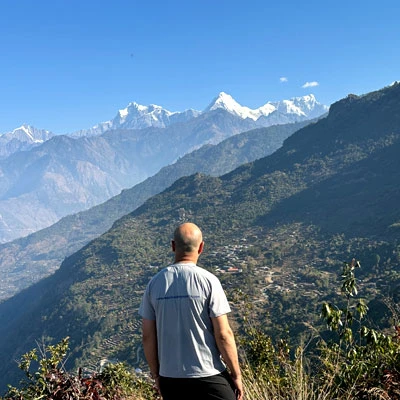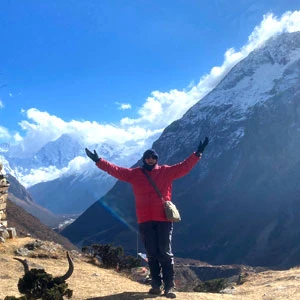Overview Of Accommodation Along The Trail
As you embark on the Everest Base Camp Trek, one of the first things you will notice is the welcoming, community-centered atmosphere of the trail's tea houses. These tea houses are run by local families, which is the backbone of the trekking community as it provides a place to rest, eat, and connect with fellow adventurers.
Generally, the tea houses are basic yet functional with simple rooms that are shared for two people. The rooms usually come with a bed, a blanket, and a pillow, though you will need to bring your own sleeping bag for added comfort, especially at higher altitudes. On top of it, you will also have additional amenities like charging stations or Wi-Fi, but they are often not very smooth.
Now, remember that, the higher you go,tea houses and facilities are more basic. In Lukla, the gateway to the trek, you will find relatively more modern facilities to ease you into the adventure. As you make your way to Namche Bazaar, you can get more private rooms and better facilities, such as hot showers. However, upwards in Tengboche, the tea houses are still welcoming but basic and by the time you reach Dingboche, the tea house is quite simple.
Beyond this, tea houses are perfect windows for a glimpse of local culture and everyday lifestyle.
Accommodation Quality And Variations
From basic to luxurious stays, you will find it all in the trails of the Everest Base Camp Trek, depending on the altitude level you are in. At a higher level, the tea houses are pretty basic and budget-friendly options which are often shared rooms with wooden beds, thin mattresses, and basic blankets. Additionally, these tea houses offer shared washrooms.
As for the luxury options or tea houses with mid-level comfort, they are only available at notable locations such as Lukla and Namche Bazaar. These tea houses offer facilities like heated blankets, en-suite bathrooms, gourmet meals, and Wi-Fi. However, such options are rare beyond the lower altitudes, and luxury fades as you venture closer to the base camp.
Food And Dining Along The Trail
Dining during the trails of the Everest Base Camp Trek offers you a taste of Nepalese hospitality, served with breathtaking views of the Himalayas. As you check the menus, you will find multiple traditional hearty meals as well as a few familiar international dishes.
As you are on this trek, do not forget the classic dal bhat. It is a nutritious combination of steamed rice, lentils, vegetable curry, and pickles on the side. The best part of this meal is that it is endlessly refillable. Apart from this dish, you will also find momo, thukpa, thenduk, potatoes, and noodles.
Now, if you are craving for a more familiar taste, you may also find items such as pasta, pancakes, and sandwiches. While these dishes may not have the authentic Western taste, they are still a pleasant change for your palate.
Here, hydration is another essential factor. Staying hydrated helps combat altitude sickness, but buying bottled water at higher altitudes can get expensive. Almost all tea houses will offer bottled water but for a more budget-friendly option, you should carry a reusable water bottle with a water purification tablet or filter so you can enjoy them from the local source. Besides water, you will also have quite a few drink options such as herbal teas, ginger-infused drinks, and lemon honey tea.
Nutritional Needs And Staying Energised
For the long days of trekking at high altitudes, you have to meet your nutritional needs to maintain stamina, recover overnight, and adapt to the physical and environmental challenges. Hence, you will need to choose high-energy foods to keep you moving on the trails.
Here, the staple Nepali food, dal bhat is a trekker’s best friend as it has a high-carb and nutrient-rich profile. Likewise, options like noodles, potatoes, and porridge can provide the carbohydrates needed to replenish your energy after those steep ascents and descents.
On a similar note, snacking is important. You should pack items such as chocolate bars, dried fruits, and nuts to munch on while trekking. They are lightweight and calorie-dense food, giving you instant energy. Also, while on this journey, why don’t you try out some local treats such as yak cheese?
Now, it will get quite easy to end up with an upset stomach along the trail. Therefore, we recommend you avoid raw salads or undercooked meats. Also, if you are drinking water from a local source, always cure it with a water purification tablet or filter at first.
Dietary Restrictions And Special Needs
While the tea houses may look basic, you will be taken care of for your special needs once you communicate with them. Whether you are vegetarian, vegan, gluten-free, or have specific allergies, tea houses along the route are generally accommodating.
As a vegetarian or vegan, you do not need to worry as there will be multiple items to accommodate your food needs. In fact, Nepal Trekking Experts ask trekkers to stick with vegetarian items as non-veg dishes, at times, may result in stomach issues. Also, if you have any dietary needs, you can clearly communicate directly with the locals or via your guide. Even simple phrases like “no meat,” “no dairy,” or “allergic to wheat” can go a long way.
Having said that, flexibility is also important. Tea houses prepare meals with locally sourced fresh ingredients which may not be available at times, hence, you must also try to adjust your preference at times.
Budget Considerations For Food And Accommodation
While the cost of food and accommodation varies as per your personal preference and altitude level, you must understand the basic expenses for them. During the trek, accommodation might cost anywhere from USD 5 to 250 per night, depending on the level of comfort and the altitude. At lower locations, the price is cheaper but the prices hike up at a higher level. These costs often reflect the increased difficulty of transporting goods and maintaining facilities at higher altitudes.
Additionally, it is a similar case with food prices, as it will start to cost more as you ascend higher. A typical meal can cost you anywhere from USD 30 to 50 per person per day. To maintain your food budget, it is best if you stick to locally made dishes rather than indulging in imported goods.
Also, remember that, with accommodation, extra facilities such as Wi-fi, charging, and hot showers will cost you an extra dollar. Likewise, buying bottled water and snacks on the trail is much more expensive.
Challenges With Food And Accommodation
The Everest Base Camp Trek is a journey of incredible highs; both literal and emotional. However, any adventure comes with a series of challenges, among which logistics and meals are one of such major challenges.
Particularly, if you are trekking during the peak season (Spring and Autumn), room availability is a major concern. If you have not booked accommodation in advance, you will struggle to search for a spot, and in the worst-case scenario, you will have to share a room with strangers or sleep in the communal hall. Hence, pre-arranging your accommodation is a must!
Moving on, inconsistent food quality or taste that does not suit your palate will be another concern. Every tea house will have a unique ambiance as well as the food taste and some may suit your preference while some may not. Therefore, you must be flexible and have an open mind to take these all up as a part of your adventure.
Tips For A Comfortable And Enjoyable Experience
- Book your accommodations in advance during busy months (March to May and October to November) to avoid last-minute stress.
- Aim to reach your tea house by mid-afternoon to secure a good room before the crowds arrive.
- Prioritize dal bhat as your meal to get unlimited refills and needed nutrition.
- Carry high-energy snacks like nuts, dried fruits, and energy bars to stay fueled between meals.
- Always carry a water purification tablet or filter if you are drinking water right from the local source.
- Use hand sanitizer before and after your meal.
Conclusion
From the local tea houses along the trail to hearty meals that fuel you for the journey, the accommodation and food during the Everest Base Camp Trek are the windows to the culture, tradition, and daily lifestyle in the Himalayas. Hence, if you understand the variability in comfort, quality, and availability at different altitudes, then, it will enrich your entire trekking journey.
As you plan your journey, remember that thoughtful preparation is your best ally. Create a well-thought-out plan but most importantly, savor the little moments: whether it’s sharing a warm meal with fellow trekkers or waking up to the sight of towering peaks outside your tea house window.







